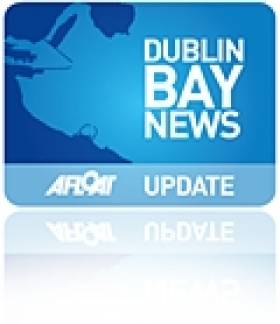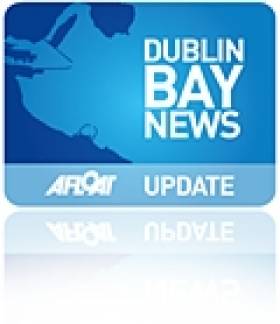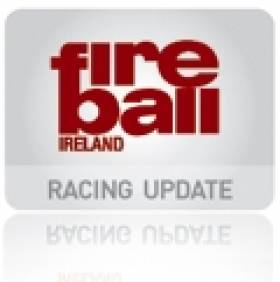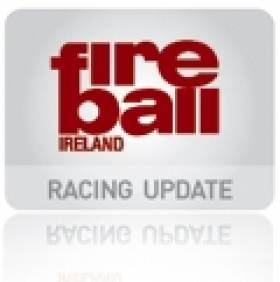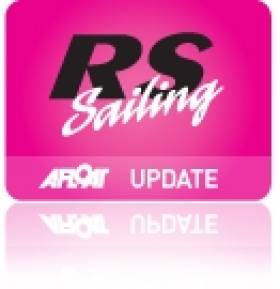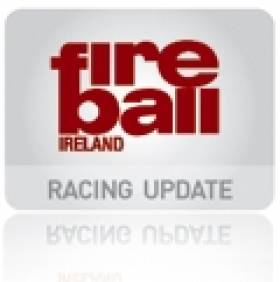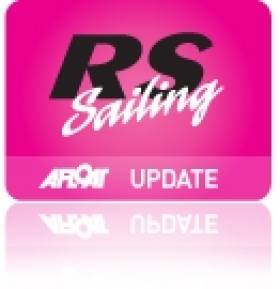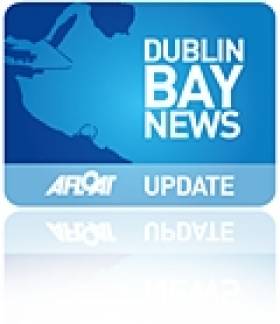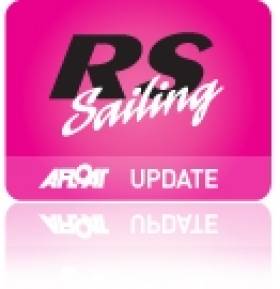Displaying items by tag: dmyc
DMYC Dinghy Frostbites Cancelled Again Due to Strong Winds on Dublin Bay
#dmyc – Due to an adverse forecast and being the Sunday that it is, the last before Christmas, today's DMYC dinghy sailing Frostbite racing was cancelled yesterday evening. It is the third such cancellation in a row for the popular Dun Laoghaire series due to strong wunds
INSS Stage Mini Frostbite Series After DMYC Cancellation
#frostbites – After the baptism of fire from the morning's DBSC Turkey Shoot racing series, it was never a sure thing that the DMYC Frostbite Series would go ahead writes Kenneth Rumball. As predicted at approximately 12:15 the code flags N over A were hoisted above the DMYC on the West Pier in Dun Laoghaire. However a number of the younger sailors from the Irish National Sailing School had already gathered in the INSS Clubhouse and were keen to get out sailing after seeing the performance of their coaches in the breeze on the previous week. Knowing the condition from the morning racing, INSS manager Kenneth Rumball assisted by Glyn Williams and Alexander Rumball allowed the 9 keen young sailors to take out three squibs with a reef in to practise their starts and do a few short races inside the harbour.
Motoring out in the INSS launch which was to act as a committee boat for the day, there were a number of Laser Dinghies out sailing and also Shane McCarthy in his Solo dinghy despite the frostbite series being cancelled. In all there were 8 Lasers and the Solo. With Kenneth already planning on setting up a triangular course, and holding races for the Squibs, we invited the Lasers and the Solo to a separate start where we ran three races for the gang. Kenneth even jumped into the Solo for race number three to get a taste for the single-hander.
Our juniors in the Squib fleet used the conditions to build on their starting techniques which they have been struggling with in the PY class of the Frostbite series. The three boats crewed by three persons each soon shook out the reefs after conditions in the harbour were considerable more tame than the Turkey Shoot in the morning. Lorcan Tighe and his gang were dominant in the squibs, notching up three wins!
Sean Craig was consistently at the front if not helped slightly by his enthusiastic starting attitude. Great racing inside the harbour for the gang with lots of photos available on the INSS Facebook page here
Sail No. Race 1 Race 2 Race 3 Race 4 Cumulative
188347 1 4 1 2 8
171694 2 1 3 5 11
5302 6 5 2 1 14
200143 5 2 4 3 14
190317 7 3 5 4 19
177854 4 7 6 6 23
190745 3 6 7 9 25
165639 9 8 8 7 32
177891 8 9 9 8 34
DMYC Frostbiters Suffer Second Cancellation
#frostbites – For the second Sunday in succession DMYC frostbites was cancelled due to strong winds.
N over A is flying from the DMYC flagpole (at 12:32) with a confirming Facebook post that Frostbite racing is cancelled again - too gusty writes Cormac Bradley.
Contrary to my report last week, there is racing on the programme next Sunday - as advised/confirmed in the NoR and SI.
But for today there will be no water borne action!!
From my office view Dublin Bay is deceptive - it is an offshore breeze so the water is flat, but there are "catspaws" of harder wind skirting across the water. Further out there are whitecaps though they are not particularly big. XCWeather had been forecasting 16 knots with gusts in the mid-twenties.
It is a bright day with grey clouds over this part of the Bay with a brighter skyline to the north and east. A rainbow has just appeared over Poolbeg to the West!
TV time then? Scarlets v Ulster in Champions Cup Rugby or Utd v Liverpool in the Premier League!!
Seven Fireballs Line Out For DMYC Frostbite Dinghy Series
#fireballsailing – Seven Fireballers headed out to the bay on Sunday afternoon for race 5 of the DMYC Frostbite series, a race in the bay gave the fireballs a chance to stretch their legs on a longer course but with the spring tides in play, some tidal calculations were needed at all the turning marks of the course. Watching the PY fleet start before, it was clear a conservative start was needed and after waiting for our turn, all seven fireballs got away cleanly with no OCSs to mention, a rare time with Irish Fireballers.
Given the shifty conditions, the first beat was almost a fetch to the weather mark and most of the fleet tacked on to port almost instantly after the start, the Clancy brothers 15113 mastered the start line and took a dominant role on the left handside of the fleet. Neil Colin and Margaret Casey 14775 went out towards the right hand side while most of the fleet kept towards the middle of the course.
At the top mark, the Clancy brothers had held their lead and rounded first, followed by Colin/Casey, then Rumball/Byrne 15058 followed hot by Butler/Oram 15061. A quick hoist saw Rumball/Byrne overtake Colin/Casey on the top reach and then set off in hot pursuit of the Clancy brothers. By the first gybe mark of the trapezoid the Clancy brother still held their lead. Up the next beat Rumball/Byrne had closed the gap while Butler/Oram had managed to overtake Colin/Casey.
Round two of the course saw some good match racing between Rumball/Byrne and the Clancy brothers with Rumball/Byrne only managing to gain first place on the next upwind leg. The race continued with little place changing from here on as far as this writer can tell.
The finishing order is below with mug winners on the day of Louise McKenna & Hermine O'Keefe.
1. Kenneth Rumball Brian Byrne
2. Conor Clancy/James Clancy
3. Noel Butler/Stephen Oram
4. Luke Malcolm/Harry O'Reilly
5. Louise McKenna/Hermine O'Keefe
6. Neil Colin/Margaret Casey
7. Mary Chambers/ Brenda Mcguire
Fireballs Benefit From Two races At DMYC Frostbites, Dun Laoghaire
#fireball – A cloudless sky and bright sunshine allowed the Race Management Team for the 2014/15 Frostbites to get in two races on a trapezoid course yesterday writes Cormac Bradley.
A new app on my phone, "Windfinder", gave me a reading of 8 knots of breeze at 15:00 coming out of the West and the nine Fireballs in the first race and the eight who finished the second race were certainly having reasonable trapezing conditions all afternoon.
I missed the first start from my shore-side location but was able to see the entire fleet go right on the first beat before tacking onto starboard in the vicinity of the harbour mouth to take the hitch in to the weather mark, which was located to the west of the approach to the inner marina.
The rounding order at this first weather mark was Kenny Rumball & Teddy Byrne (15061), Conor & James Clancy (15113), Noel Butler & Stephen Oram (15058), Luke Malcolm & Harry O'Reilly (14790) and Alistair Court & Gordon Syme (14706).
The top leg of the trapezoid was a tight spinnaker reach with the gusts coming out of the approach to the inner marina adding a bit of spice to the leg. Mark 2 was situated close to the end of the HSS gantry which gave boats the choice of gybing immediately at No.2, or continuing towards the HSS gantry and gybing later. In the first round, Frank Miller and Grattan Donnelly were the only ones to exercise the first option.
This leading group of five boats were not really pressing each other; the two which were closest were Court and Malcolm at the tail end. However, at Mark 3, a red spinnakered boat capsized and it was only at the next weather mark that I was able to establish that it had been Messrs Butler & Oram who has slipped up – most unusual – leaving them behind the entire fleet.
Rumball appeared to pull away from Clancy between 2 and 3 and on rounding 4 went all the way across to the harbour mouth on port before tacking for No.1 for the second time. Clancy followed suit. A number of boats went left but this did not have any real effect on the top order.
An established running order of Rumball, Clancy, Malcolm and Court saw out the balance of the race while Butler & Oram started their chase from the back of the fleet. Rumball played a slightly conservative game on the third and fourth beats seeming to take a hitch to the left before going right again to cover Clancy. The distance between these two fluctuated over the last two laps but Rumball was never really threatened.
Mary Chambers & Brenda McGuire (14865) decided that conditions were right to give their sails a wash in the briny with a slow motion capsize on the top leg of the third lap. The bottom leg of the course was becoming tighter with some boats two sailing from Mark 3 to Mark 4.
By the last weather mark Rumball was comfortably in the lead, Clancy was secure in second and Luke Malcolm was in the Mug winning slot. This remained the status until the finish, but Butler had recovered to sixth (by my count) at the line.
The course was tweaked for the second race and at the start the nine Fireballs were jockeying around the committee boat. Louise McKenna & Hermine O'Keeffe (14691), were furthest away while Luke Malcolm hovered outside the starting box and came in slightly later to hog the slot closest to the committee boat end. Three boats bailed early to go right towards the harbour mouth, while Frank Miller and Louise McKenna worked the left hand side. By the time the fleet converged on the first weather mark, there were five boats in a tight bunch – Clancy, Rumball, Malcolm, Butler and Miller. Alistair Court bailed at this stage with a breakage of some sort, leaving eight boats to contest the race.
Again the top reach was a proper 3-sailer, but the change in position of Mark 2 took the HSS gantry further out of the equation and boats had to make a distinct change of course at 2 to get on the rhumb line for 3. Clancy and Rumball sailed these two legs in close company and a flurry of gybes in the latter half of the leg to 3 saw Rumball get the inside slot at 3 and the lead of the race. He didn't let it go! From 3 to 4, Miller and McKenna had their own private race going hard to weather in a tight luffing match.
For the second beat, the majority of the fleet went right again, but "three Amigos" went left – Miller, McKenna and Chambers. Miller worked the left hand side to maximum effect and running out of sea-room executed what should have been a normal tack – except that he hovered on the brink of a capsize for a short time before good crew work got the boat back on an even keel. Trouble was that the exertions to keep the boat upright led to his crew's "centre of gravity" being outside the boat, so a secondary scramble was required to prevent him going overboard.
At what was to become the last weather mark, the order was Rumball, Clancy, Malcolm, Butler, McKenna, Neil Colin & Mary McGuinness (14775), Chambers and Miller. However, between 1 and 2 Butler overtook Malcolm by sailing a higher line and extending that line beyond 2. Malcolm gybed at two to head into the body of the harbour, but by the time 3 came round, he had lost to Butler.
As the leaders approached Mark 4, the Irish Lights vessel Granuaile entered the harbour prompting a shortened course signal by the Race Committee.
Thus the finishing order, based on the sequence of spinnakers on the bottom of the trapezoid, was, Rumball, Clancy, Butler and Malcolm. This result gave Messrs Butler & Oram the second Mug of the Day.
DMYC Frostbites 2014 – 15
Results after 4 rounds, no discard. Sail No. Club R1 R2 R3 R4 Tot Pts
1 Kenneth Rumball & Brian Byrne 15058 INSC 1 1 1 1 4
2 Noel Butler & Stephen Oram 15061 NYC/DMYC 2 3 6 3 14
3 Luke Malcolm & Harry O'Reilly 14790 Howth 7 4 3 4 18
4 Conor & James Clancy 15113 RStGYC 13 2 2 2 19
5 Frank Miller & Grattan Donnelly 14713 DMYC 3 6 5 8 22
Neil Colin didn't have regular crew Margaret Casey on board yesterday but a former Fireballer, Mary McGuiness. Since leaving the fleet 10 years ago Mary McGuinness, the former owner of 14374 , has become a fully-fledged Jedi (J109) with a Fastnet T Shirt in her wardrobe. They launched early and experimented with the joys of symmetrical kites, re-familiarised with the trapeze and balance factor and were then ready for the off, after some encouraging comments from the front runners, whom they later came across in a soggy state!( A rare swim for 15061).
14–Boat 'Boisterous' RS Fleet Sailing in DMYC Frostbite Series
RSsailing – RS Sailors were on the water in Dun Laoghaire for yesterday afternoon's latest round of the DMYC dinghy Frostbite series writes Sarah Byrne.
With a lovely westerly breeze forecast on a crisp cloudless afternoon in the busy harbour, PRO Olivier opted for two races 'inside' on the default trapezoid. 14 boats on the RS start line proved boisterous and noisy at the Committee boat end, one OCS By Alexander Rumball in 1143 and a lone 200 owning the pin end.
The first beat proved uneventful with a cluster at the first mark and prompt hoists separating the wheat from the chaff down the first reach. At the second mark, some gybed away from the breeze bouncing around the HSS pier, only to arrive together again but with water at the next mark, then heading up onto a rather tight reach with some being forced to drop their kites. Multi fleet traffic forcing tacks spread the fleet further on the second beat. Marty & Rachel managed to maintain their lead throughout the four laps in the 200 fleet; Totts/Kelly battled with Enzo/Tom while Sarah/Katie hot in pursuit performed a particularly idiotic capsize to put them out of the race. Marty and Rachel came in just 1 second (on PY) behind the lead 400, Ross McDonald and Peter Bayly, taking joint second with Emmet and James Ryan.
Counting down to race two, with those in shorties beginning to get a bit chilly, the fleet were less unruly on the start line and again a lone boat owned the pin end. Two thirds up the first beat, the wind dropped and shifted a little to the north and hey ho a fishing boat comes barging through the fleet towards the first mark, messing it up a tad. Again Marty had made it first 200 to the top mark hunting down the new 400 pairing Sean Clery and Ronan Jones throughout and finishing together. Totts and Myles stayed just out of Sarah and Katie's reach for two of the three lap race when it was sadly and prematurely shortened as the Grannuaile demanded her passage through the course. On PY Marty and Rachel yet again owned the race, the Ryan Bros. and Andrew Algeo and Paul Nolan came in second and third overall.
Maeve Rafferty loving her new hull – thank you RS sailing! Quite the pleasant afternoon! The weekly Mug went to Ross McDonald and Peter Bayly for the first race and Emmet and James Ryan for the second race.
Fireballs Break out of the Harbour For Dun Laoghaire Frostbite
#fireball – The third Sunday of the 2014/15 Frostbite Series saw the fleet break out of the constraints of Dun Laoghaire harbour and race offshore yesterday writes Cormac Bradley. My interaction with the fleet afterwards suggests that the dominant feature of the day was the big sea running outside the harbour, which combined with a light-ish breeze, gave everyone a bit of a challenge.
A five lap trapezoid course was set with a separate weather mark for the Fireball fleet. My contacts also suggested that there was a lot of place changing going in the bottom half of the fleet, but couldn't offer a "blow by blow" account of what was going on ahead of them.
However, I was told that for the second week in a row, a member of the fairer sex became detached from her boat and had to be rescued by her (female) crew. Well done Hermine! The previous week, in zero wind, another all lady team capsized while they floated around waiting for the wind to fill in..........which it never did. Oops, Mary & Brenda!
As I was not present to watch the racing and with it being offshore I might have had difficulty anyway, a detailed account of the racing is not available! Apologies!
However, I can surmise that with a finishing order of;
1. Kenneth Rumball & Brian Byrne INSC 15058
2. Conor & James Clancy RStGYC 15113 (adopted number)
3. Noel Butler & Stephen Oram NYC 15061
There would have been lots of fun and games at the front end of the fleet. Neil Colin admitted to being asleep at the start with his watch being a minute out, so he and Margaret (14775) spent the rest of the race catching up.
Alistair Court & Gordon Syme were pleased to find that their efforts had resulted in a 4th place finish.
With Rumball & Byrne also winning the first round race, yesterday's Frostbite Mugs went to the Clancy Brothers.
Irish Fireballers are reminded that the Class Prize-giving takes place on the last Friday of November, the 28th, in the National Yacht Club. In addition to awarding prizes for the season-long Traveller's Trophy, there are a number of Class Awards to be handed out – The Asterix Trophy, The India Trophy, The Captain's Trophy, The Lady's Trophy & The Liam Bradley Trophy. It is also an evening where the season-long post-mortems take place.
Hope to see you there! Please let a committee member know if you will be in attendance
Big RS Fleet Turnout for DMYC Frostbite Series Off Dun Laoghaire Harbour
#rssailing – Sunday 16th dawned bright and breezy, but as the RS fleets launched into Dun Laoghaire harbour, the breeze had dropped right off to a shifty five knots for the DMYC Frostbite Series. The fleet was sent outside for racing, and fortunately the breeze decided to play ball and built to a pleasant 10-15 knots from the North East.
After a short postponement, the rs's were the third fleet to start, with a favourable pin end. The fleet jockeyed to get of the pin, with four boats OCS, Mark Nolan and Heather Craig, Andrew Algeo and Paul Nolan, Marty O'Leary and Rachel Williamson and Chris helme and Alan Claffey.
Marty and Rachel were the sole boat to turn around and restart and were left to chase the fleet up the first of 5 beats. By the windward mark, the fleet had compressed, with some snakes and ladders up the beat. Marty and Rachel rounded first, hotly pursued by Sarah Byrne.
Up the second beat Sarah Byrne broke into the lead, only to be reeled back in by mark and heather sailing 1015 and Marty and Rachel sailing 1170.
Th final order of the 200s was to be Marty and Rach followed by Mark and Heather only to realise they were OCS, leaving second place to Sarah Byrne, 3rd spot went to Chris and Emily Arrowsmith.
RS400 Fleet
The 6 strong 400 fleet had a battle royale from the off.
After what can only be described as a pin end frenzy of a start - Leg 1 saw Andrew Algeo & Paul Nolan (1335) and Emmet & James Ryan (1339) nip out in front from the left side of the course. These were closely followed by newcomer Rumball, with Kingston and Cleary joining the chase from the right side. The first windward mark saw the 5 frontrunners pop kites almost simultaneously, and peel onto a lively leg 2 in surfable swell. Ryan's hoist resulted in a slightly ripped kite, and Rumball (1143) slipped back to 4th, allowing Kingston to slot into third as the pack settled, and planed on downwind.
The next 3 rounds of the trapezoid course saw position changes on almost every leg. Chased hard by Kingston, Algeo (subsequently scored OCS) hung on to pole position for a good portion of the race. The Ryans gallantly powered on with their ripped kite in 3rd, and managed to keep Alexander Rumball, Sean Cleary (1017) and Brian O'Hare (582) at bay. Kingston & Mcnamee finally managed to reel Algeo in on the third round, and went on to put a good distance between themselves and the fleet over the final 2 laps to take another win in the 400 class and the DMYC mug for the day's racing.
DMYC Frostbite Racing Abandoned Due To Lack of Wind on Dublin Bay
#frostbites – Dun Laoghaire harbour was quite a soggy scene when a downpour hit the DMYC Frostbite fleet just before the scheduled start of proceedings and whatever wind there might have been was killed off shortly thereafter writes Cormac Bradley.
From a waterside location, just on the seaward side of the Dun Laoghaire marina, the committee boat started off at the mouth of the harbour and progressively moved inshore until it was just to the west of the gantry for the HSS ferry. A substantial fleet of Lasers, RSs, IDRAs and nine Fireballs floated around the committee boat until, just after 14:30, three blasts of the starter's horn brought proceedings to a close.
By that stage the atmosphere was starting to improve, the rain had disappeared off to sea but stillness descended to replace it. The air temperature wasn't bad at 10˚, but the fleet would have a long sail home.
Record 16 RS Dinghies For DMYC Frostbites In Dun Laoghaire Harbour
#dmycfrostbites – Sunday morning dawned bright and sunny, with a gusty 15 knots in Dun Laoghaire harbour writes Marty O'Leary. A record 16 RS dinghies gathered on the startline for the first race of the series of the DMYC frostbites, enjoying exceptionally warm weather for this time of year. Dun Laoghaire welcomed several familiar faces, as well as some visitors from Greystones and further afield.
The race officer set the course at four laps of a trapezoid course based inside the harbour, and racing got off to a clean start, with just one 200 being called back for being a bit too keen.
The early leaders popped out from the left, however no one was safe, with lead changes every leg. First to the windward mark was Sean Clery and new crew Donal Murphy in the 400, followed by Marty O'Leary and Rachel Williamson in the 200. Both boats opted to gybe early at mark two, and were left to watch as the boats that continued on sped by on the right hand side of the run.
It was then the turn of Emmet and James Ryan to take the lead up the second beat, and were looking comfortable as they hoisted the kite - until they managed to get tangled up in a laser, leaving the way clear for George Kingston and Ian McNamee to nip in, and take the lead, chased hard by Andrew and Paul.
The 200s were having their own battles,with O'Leary and Williamson taking an early lead, as class president Frank sailing with Heather Craig, had to turn back and re-cross the line for being OCS. Frank and Heather sailed hard, and chased down the pack and had a great tussle with Conor Totterdell and Myles Kelly. They successfully climbed back to 2nd, but didn't manage to catch O'Leary and Williamson, who collected the weekly mug for the RS's.


























